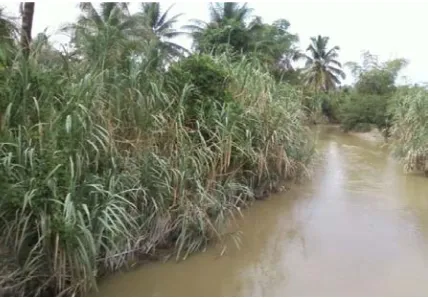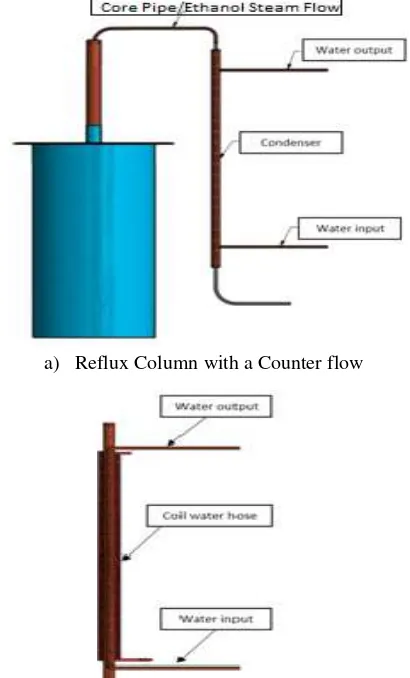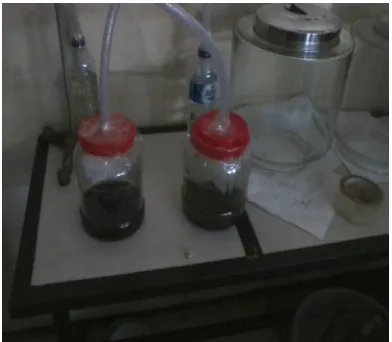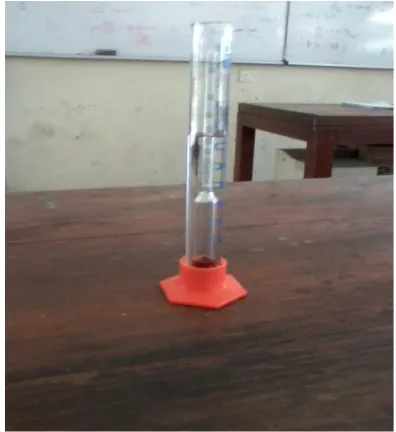DESIGN AND CONTRUCTION OF SIMPLE DISTILATION UNIT WITH REFLUX
COLUMN MODEL FOR TIBARAU SUGARCANE (
Saccarum Spontaneus Linn
.)
BIOETHANOL PRODUCTION
Hasanuddin1, Hendri Nurdin2, Waskito, Syahrul3
*) Mechanical Dept. Technical Faculty- Padang State University
ABSTRACT
Writing this article is to present the draft to build and develop a simple distillation unit with reflux column models. As well as part of the research objectives to produce bioethanol from the fermentation of the base material for the production of (biomass) in the form of plant cane tibarau (saccarum spontaneus Linn). The production of bioethanol in the context of the research-oriented development activities biofuels, which is referred to as gasohol consists of a mixture of bioethanol with premium. For this purpose, among others, we need a system that is trustworthy distillation equipment to obtain the quality bioethanol eligible. One system equipment in question is the model of reflux column. Results can then be applied to the design industry efforts household scale, so that the industry can cultivate and develop bioethanol raw materials are in short supply in their environment such as sugar cane plants tibarau that have untapped potential.
Index Terms :
1.
INTRODUCTIONAwareness of the world's energy needs and the increasing tendency of the limited resources of primary energy today especially petroleum, encourage people to continue to seek and develop alternative renewable energy. Among others in this regard is to develop and adopt the use of biofuels.
As one form of renewable energy derived and processed from organic materials either directly from herbs/plants, or indirectly prepared from industrial waste and agriculture, then this form of energy is classified as biomass energy, where its presence can be either or in the form solid, liquid or gas.
Biofuels has the potential to be used as a substitute for fossil fuels such as petroleum and coal, mainly gasoline or diesel. These fuels can be produced through a simple scientific process without the need of sophisticated machinery and equipment as is required in the production of oil and gas. Biofuels can occur in a hydrocarbon compound with chemical formula CH5OH, and known as ethyl alcohol
produced from crops/plants, where the later type of fuel is more popularly known as bioethanol.
Bio Ethanol according to a series of process, formed by fermentation of sugar from sugar cane plant material or an extract of vegetables and fruits such as potatoes, corn, wheat and other things that contain sugar, and can be a source of raw material. In the context of this study used the type of base material of wild plants (shrubs) that its sugarcane tibarau (saccarum spontaneum Linn) as shown in Fig.1. According to Reza Fahlevi and Chakra DM (2009) research results, this plant contains glucose, cellusose
and hemi cellulose, starting from the stem to the leaves, which is possible as a basic ingredient in the process and the formation of bioethanol.
Figure 1. Photo Plants Tibarau Sugarcane Characteristically Non-Crop Cultivation Growth in
Suburb River
Changing the yeast enzyme simple sugars into ethanol and carbon dioxide by chemical reactions in fermentation activity is shown by the simple equation below. Actually, the process is very complex because of the existence of other substances that are formed, include oil glycerin, and various organic acids resulting in unwanted side reactions.
C6H12O6→ 2C2 H5OH + 2CO2
tibarau sugarcane. The pretreatment process aiming to improve the conversion rate of the base material, in order to obtain the results and efficiency in ethanol production more economical than plants and plant energy potential. It involves a variety of technologies to promote activities such pretreatment prior to the fermentation process. Included in this is the distillation of activity as an effort for the conversion of basic material intended.
After the fermentation process takes place and successful then the next stage will be followed by distillation (refining), namely, extraction and separation of ethanol from the mixture with water. In this case there are a number of techniques and methods, one of which is through the distillation in the column/tower reflux. This method is quite simple, without using a container-legged condenser coils (feedstock system) as long as it is widely known (traditional) in activity based condensing steam distillation.
2.1.Sustainable Biofuels as Energy Source for the Future
The production of biofuels has a beneficial impact in order to improve the sustainable supply (supply) of fuel for the future. Biofuel does not cause as much air pollution and environmental hazards created by fuel oil. This does not contribute to the greenhouse effect of carbon dioxide or to environmental problems such as global warming (Keeney and DeLuca, 1992). Ethanol is an octane booster agents and anti-knocking, which need digalakan development as a fuel.
Activities through the development of the biofuel production chain are economically able to provide employment and socio-economic development in rural areas. The use of ethanol as a fuel is able to reduce the foreign trade imbalance which is detrimental in contact provision and the needs of the domestic fuel supply and national energy security. Benefit ratio biofuel production costs may be higher than the fossil fuels but biofuels do not contribute to the greenhouse effect problem which is a major problem in today's world. Compared with other energy sources are already known, the development of fuel bioethanol project more credible as a biofuel (Colmac 2009; Van Gerpenet al, 2007).
The traditional method of distillation feedstock in the system involved the use of a condenser which consists of coils/rolls the pipe or pipe insertion in the jacket fins. Distilled in this way is usually characterized by a mix of products in the form of refined products is still relatively much water.
Inevitably this way would require several times the process to obtain a better quality ethanol.
2.2.Description Results Design of Distillation
Systems Unit
A bioethanol distillation tank is designed and constructed as shown in Figure 2. where the machinery or equipment system is planned and has the ability to process 150 liters of substrate (for weighing approximately 160 kg of sugarcane tibarau). Equipment units are designed to filter out material fermented products such as glucose, sucrose, and fructose derived from the juice (juice) sugar cane or (brix solution) as well as other products such as sugar cane waste material stems and similar products.
Is a model of distillation with Reflux Still Internal condensor (IRSC) in the form of peripheral equipment that is controlled by an internal process of re-distillation and separation of the final result. Cooling takes place through the circulation of water in the condenser pipe and using a water tank in the tower filled with the mediation of the transfer pump. The capacity of the pump power of 1.0 hp capable planned to raise water to the top of storage tank (reserevoir) and maintain a stable flow to circulate water in flow range 500 - 1000 liters/hour.
2.
DESIGN AND CALCULATIONASSUMPTIONS
It takes a cylindrical-shaped tube is regarded as a boiler or evaporation tank for this refining system with a capacity to process about 150 liters of 160 kg tibarau raw material sugar cane. By the size of the volumetric capacity of the boiler is determined through a formula statement presented in equation (1) and (2). The maximum height of the tank was selected/designated as high as 0.9 m. Guided by the analysis of the draft proposed by Olaoye (2011) as well as a little modification based on a variety of other literary sources, it can be done analysis for the calculation of the following design requirements, Distillation tank payload capacity (boiler) is calculated,
Gv = Vb ρb (1)
where, Gv = Capacity (mass) tank/boiler (kg)
Vb = Volumetric tank capacity (m3) ρb = density of the product/boiler (kg /m3) whereas the distillation tank volume is,
Vb= π r2 h (2)
where,
Vb = capacity or volume of a cylinder/tank (m3) r = radius of the tank / boiler (m)
Thermal properties of ethanol and engineering materials, likely media boilers, thermal energy, and also sources as well as materials obtained from various sources distillation leteratur, consisting of: the specific heat capacity of ethanol is taken as (ceth =
2.44 kJ/ kg-K) at the level of density ( specific mass ; ρeth = 798 kg/m3) ; latent heat of evaporation is
approximately (L = 839,3 kJ/kg-mole) and the boiling temperature is 78.5 ° C ( Misau,et al 2008, Diesel, 2009). While the source of thermal energy for distillation system will come from fuel wood, and / or may also be replaced with fuel briquettes from coal/charcoal and bagasse, its density is set around, ρwood = 208 kg/m3 (Simetric & Co., 2009), as well as
heating value of wood fuel is Hwood = 15,000 kJ/kg (
Bilad, 2015).
The flow rate of water into the cooling jacket (the condenser pipe) is expected to be slower compared to ethanol vapor flow rate into the distillation column reflux to occur effectively. Based on the legal principle of continuity of the fluid flow in this case is constant, the rate of ethanol is planned at the level of the volumetric flow 0.003 m3/sec and distilled water flow rate of the pump is much slower than ethanol steam flow, i.e at a rate of 0.001 m3/sec.
To that end, selected the corresponding pump, in order to obtain effective cooling and also planned to pump in this case (function) to raise water into the storage tank can be controlled automatically high surface water to remain stable circulation. The amount or volume of water needed to cool the steam condenser ethanol in determining the volume of the water tank. In this case the volume of water is calculated by equating the amount of heat energy lost from ethanol steam with heat energy obtained/absorbed by water, (Equation 3).
The volume of water required at maximum operating capacity is 100 liters or ( mw = 100 kg)
and the water reservoir tank elected capacity is 250 liters. Balance of heat energy (Principle Black),
mw cw ( tw - t28 ) = metha . Letha (3)
Through the mediation of analytical results of
calculation
of the equation will be obtained massamounts of ethanol evaporates.
2.1. Requirements and Heat Energy Source for
Distillation Process
Heat energy required to raise the temperature of ethanol is taken out of the reach 28o C to 78,5o C, so the boiling temperature of ethanol is calculated by equation (4) and the quantity of heat energy, q to turn ethanol into steam at boiling stage is determined by using Equation (5) that,
q = m c ∆𝑡 and q = m L (4) / (5)
where,
m = mass of raw material fermentation (kg)
c = Specific heat fermentation feedstock (kJ/kg K)
L = Latent heat of evaporation (kJ/kg)
∆𝑡= change in temperatur (o C)
The heat energy required to raise the temperature to the desired temperature, 78,5o C is 7,972.02 kJ, while 1.846 kJ is the amount of heat energy required to convert ethanol into steam. So the total amount of energy required to evaporate the ethanol is 9.818,02 kJ/ sec. The mass amount of firewood / fuel needed to supply the amount of heat energy required to evaporate the ethanol was calculated from the fuel consumption is 15,000 kJ / kg. Therefore, the amount of fuel wood needed as much as 0.654 kg / sec
2.2. Flow and Capacity Water Pump
Ethanol vapor increased by 0.003 m3 at reflux column every second. The amount of heat energy supplied/supplied, Q move the particles of steam at the level of kinetic energy. The speed associated with the increase in the volume of ethanol vapor in a reflux column presented by equation (6), while the reflux column diameter is determined by using equation (7) thus obtained:
A = the flow cross-sectional area (m2 )
ceth = specific heat of ethanol (kJ / kg K)
h = length / height of the column (m)
d = diameter of the column (m)
∆𝜽 = change distillation temperature (o C) t =
time (sec)
Rom
Equation (6) and (7) obtained volumetric flow rate, in which ethanol vapor rises to the top of the reflux column and the diameter distribution pipe, i.e. column is calculated as 0.003 m3/s and a diameter of 40 mm or 1.5 inch. Each pipe is made of copper material, chosen because of the nature of inertia (inertia), which could limit the reaction with ethanol evaporated. Reflux column (condeser part) has a surrounding water jacket for cooling influence the activity of ethanol vapor. Specifically on the outputs (condenser), the planned reflux column with two cooling methods that are based on the principle of heat exchange flow, that are opposite /counter flow model and counter & circular/multipass flow model.To model the opposite flow, pipe refluxnya column contained a core pipe in which ethanol vapor flowing in the opposite direction of the flow of cooling water, that flowing on the side on the outside of the core pipe reflux column. As for the models of heat exchange in the opposite direction (counter & circular ), in the core pipe essence flowing cooling water and around the flowing vapor ethanol, then in the outer portion of the pipe reflux condenser wrapped around the pipe / hose water additional cooling so that the vapor of ethanol chilled to double (from the outside and the inside).
A pump is required and installed to raise the water to a reservoir / tank which is placed on the tower so that the water circulation occurs through a condensation unit and a jacket reflux column. Pump capacity is determined based on the volume of water to be circulated from the reservoir continues to enter / for condenser or jacket water for cooling the column reflux, head total circulation and flowrate demand, as shown by (equation 8), which is applied according to Khurmi (2005) and force pump Recommended for 1 HP (or approximately 746 Watts).
P = ρ g H Q (Watt) (8) where, P = propulsion pump (watt)
H = h + hf = height + increase in friction head
(m)
Q = flow of water (m3/ s)
Orthographic projection images for the manufacture of refining system is presented in Fig. 2, which shows a front view of some components of the machine. Boiler tank was first made before the setting and connecting piping. The precision of certain options to allow the best materials to get a quality of the tank and the column along with the reflux condenser section, so that the resulting system of steam distillation and ethanol quality.
2.3.Manufacturing Process and Systems
Distillation Unit
The construction of engineering results was carried out at the fabrication workshop of Mechanical Engineering Departement- Technical Faculty, Padang State University. The fabrication jobs consists of a number of activities, such as cutting sheet steel plate and stailess steel into desired size, as well as welding work on the same material based on the results of the design, along with other work to ensure the toughness and strength equipment unit.
a) Reflux Column with a Counter flow
b) reflux column with a Counter & Circular Flow Figure 2. Projection Drawn for Making Distillation
Parts unit and the components as shown in Figure 2, is connected to the welding work perfectly with each other to avoid leaks that cause losses steam
flow. Boiler tank (boiler) is first made /worked in the manufacturing process before setting up and connecting pipes reflux column.
For more details look distillation machines complete manufacturing yields shown in Figure 3 with two models: (a) the principle of counter flow, (b) the principle of counter flow and a circular (/multipass flow)
(a) Reflux with Counter flow System (b) Reflux with Counter & Circular Flow System
Figure 3. Distillation Plant with Reflux Column System -As a Result of Design and Contruction for Small Scale Industries
3.
Materials and Distillation MethodsThe materials used for bioethanol distillation procedure includes the fermentation of raw material/substrate tibarau cane plants, either processed from pulp stem and drops/water sugar cane. For the fermentation of waste materials/residual stems (baggase), first used as flour after cracker and milled by machine (disk-mill). Then on the base material can be made acidic or alkaline hydrolysis process, with the addition of 0.1 m H2SO4 or liquid NaOH
according pretreatemen process/hydrolysis desirable to adjust the solution to pH levels, warm water to inject pure yeast. Yeast function is as a catalyst to improve the fermentation process, while for the other equipment is used, such as pH meters, alkoholmeters,
as well as brix sugar measuring instrument (hand refractometers).
If using drops/brix from sugar cane tibarau material for fermentation, the base material must first be squeezed to take water from tibarau steem broking squeezer machine/ milling (mill press). Subsequently, the juice is heated with a flame that was to manufacture brix/solution contains a certain percentage of glucose levels.
After fermentation of the basic ingredients of the sugar cane tibarau (saccarum spontaneum L.) were conducted during the interval of 5-20 days, then followed by a distillation process to obtain sugarcane bioethanol tibarau. Figure 4, is a fermentation process of cane powder tibarau process alkaline hydrolysis and fermentation of sugarcane brix tibarau.
Figure 4. Basic Materials Processed of Cane Tibarau for Fermentation Process
For example, the basic material distilled from the fermentation of molasses/cane juice tibarau with a brix level of 30 % was obtained alcohol content of the ethanol through alcoholmeters test equipment by 40% as in Figure 5. The operation of the distillation system design results is to work with a relatively good speed which is the production levels of 0.3 liters per hour for a tankage capacity of approximately 5 liters of distillation of fermented sugarcane tibarau with a brix level of 30 %.
Figure 5. Level Alcohol Distillation Results of Tibarau Brix
The Sugarcane bioethanol distillation Tibarau
results
will be processed further, to obtain the levelsof ethanol/alcohol representative used as transport fuel mix. With the improvement of pretreatment / hydrolysis process and the provision of lime shells in order to be able to eliminate the water content is still stored in ethanol and also as effort to improve quality (pure ethanol is obtained and an increase in heat energy).
4.
CONCLUSIONSThis paper concludes the research results with some consideration for the interests of engineering and distillate fuel bioethanol, is as follows:
a. Sugarcane Tibarau (Saccarum spontaneus L.) has potential as an energy plant that can be processed and conversion into fuel bioethanol
b. One model for the needs of bioethanol is a simple distillation with reflux column unit, in addition to the traditional model (feedstock system), namely the improvement of the system portion condenser with heat exchanger concept (counter flow system and a combination of counter and circular flow system).
c. To design Reflux distillation column models should be analysis of the calculation, the amount of ethanol vapor mass and volume, the amount of circulating water needs heat energy balance, as well as setting some assumptions and corresponding material choices.
d. The simplicity of the system and process as well as the affordability levels in terms of knowledge and financing for the implementation of bioethanol distillation system unit on a smaller scale have to be the main rationale for the future. e. Tibarau cane plant is a kind of energy that has
been forgotten, saw its potential needs to be lifted to the surface into cultivated plants / industry so that economic value for society
5.
REFERENCESAnonymius (unyear), Building A Home Unit Distillation Apparatus, http//www google, Acsessed April, 2015.
Bayazitoglu, Y and Ozisik,M.N ( 1988 ), Elements of Heat Transfer, Mcgraw Hill Book Co, New york.
Bilad, M.Roil (2011), Analis Kalor Pembakaran dan Harga Berbagai Alternatif Bahan Bakar Pengomprongan Tembakau Virginia, https//roil bilad wordpress.com, Acsessed on Augustus 1,2015
Biodiesel ( 2009 ), Methanol Handling Guide,
http://www, org, pdf files methanol handling ,Acsessed on July 30, 2014
Colmac (2009), Fuel from Ethanol, http/www.colmac.com/fuel
ethanol.htm,Acssed on July 30, 2014
Hasanuddin ( 2015) , Pengembangan Bahan Bakar Bioethanol dari Tumbuhan Tebu Tibarau dengan Penambahan Zat Kapur Kulit Kerang untuk Peningkatan Energi Panas, Lembaga Penelitian UNP Padang
Hasanuddin ( 2013 ), Model Pengembangan Rintisan Program Diversifikasi Produk Melalui Pengenalan Bahan Bakar Briket Ampas Tebu pada Pengrajin Industri Gula Merah di Kabupaten Agam, Lembaga Penelitian UNP Padang
Prospect, http//www.google, Acssed on July 25, 2015
Khurmi,R.S ( 1980 ), Hydraulics, Fluid Mecahnics and Hydarulics Machines, Erausia Publishing,New Delhi
Misau,et al (2006), Production of Bioethanol from Sugarcane: A Pilot Scale Study in Nigeria, Chemical Engineering Program, Abubakar Tafawa University, Bauchi-Nigeria
Olaoye,J.A ( 2011 ), Design and Contruction of A Reflux Column Distilation Unit for Bioethanol Procduction from Sugar Cane Substrate, Agricultural & Biosystem
Engineering Departement University of Ilorin-PMB,Nigeria
Reza Fahlevi dan Cakra D.M ( 2009 ), Pretreatment Saccarum Spontenus Linn dengan Metode Hot Compressed Water, Lab. Biomassa & Konversi Energi ITS Surabaya.
Rosentrater, K. A (2006 ), Physical Properties of distilation Dried Grains with Solubles, http/www,google. Acsessed on July 25, 2015



